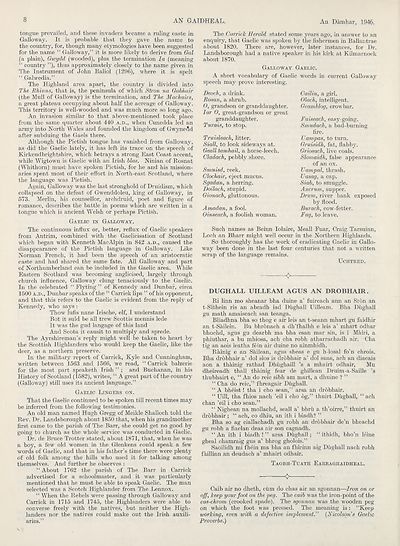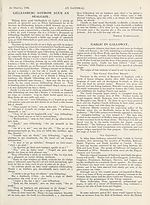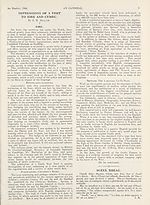Download files
Complete book:
Individual page:
Thumbnail gallery: Grid view | List view

AN GAIDHEAL.
tongue prevailed, and these invaders became a ruling caste in
Galloway. It is probable that they gave the name to
the country, for, though many etymologies have been suggested
for the name “ Galloway,” it is more likely to derive from Gal
(a plain), Gwydd (wooded), plus the termination la (meaning
“ country ”), thus approximately closely to the name given in
The Instrument of John Baliol (1296), where it is spelt
“ Galwedia.”
The Highland area apart, the country is divided into
The Rhinns, that is, the peninsula of which Stron na Gahhair
(the Mull of Galloway) is the termination, and The Machairs,
a great plateau occupying about half the acreage of Galloway.
This territory is well-wooded and was much more so long ago.
An invasion similar to that above-mentioned took place
from the same quarter about 440 a.d., when Cunedda led an
army into North Wales and founded the kingdom of Gwynedd
after subduing the Gaels there.
Although the Pictish tongue has vanished from Galloway,
as did the Gaelic lately, it has left its trace on the speech of
Kirkcudbrightshire, which betrays a strong East Coast accent,
while Wigtown is Gaelic with an Irish Mas. Ninian of Rosnat
(Whithorn) must have spoken Pictish, for he and his mission¬
aries spent most of their effort in North-east Scotland, where
the language was Pictish.
Again, Galloway was the last stronghold of Druidism, which
collapsed on the defeat of Gwenddoleu, king of Galloway, in
573. Merlin, his counsellor, archdruid, poet and figure of
romance, describes the battle in poems which are written in a
tongue which is ancient Welsh or perhaps Pictish.
Gaelic in Galloway.
The continuous influx or, better, reflux of Gaelic speakers
from Antrim, combined with the Gaelicisation of Scotland
which began with Kenneth MacAlpin in 842 a.d., caused the
disappearance of the Pictish language in Galloway. Like
Norman French, it had been the speech of an aristocratic
caste and had shared the same fate. All Galloway and part
of Northumberland can be included in the Gaelic area. While
Eastern Scotland was becoming anglicised, largely through
church influence, Galloway clung tenaciously to the Gaelic.
In the celebrated “ Flyting ” of Kennedy and Dunbar, circa
1500 a.d., Dunbar speaks of the “ Garrick lips ” of his opponent,
and that this refers to the Gaelic is evident from the reply of
Kennedy, who says :
Thow lufis nane Irische, elf, I understand
Bot it suld be all trew Scottis mennis lede
It was the gud langage of this land
And Scota it causit to multiply and sprede.
The Ayrshireman’s reply might well be taken to heart by
the Scottish Highlanders who would keep the Gaelic, like the
deer, as a northern preserve.
In the military report of Garrick, Kyle and Cunningham,
written between 1563 and 1566, we read, “ Garrick balzerie
for the most part speaketh Irish ” ; and Buchanan, in his
History of Scotland (1582), writes, “ A great part of the country
(Galloway) still uses its ancient language.”
Gaelic Lingers on.
That the Gaelic continued to be spoken till recent times may
be inferred from the following testimonies.
An old man named Hugh Gregg of Meikle Shalloch told the
Rev. Dr. Landsborough about 1850 that, when his grandmother
first came to the parish of The Barr, she could get no good by
going to church as the whole service was conducted in Gaelic.
Dr. de Bruce Trotter stated, about 1871, that, when he was
a boy, a few old women in the Glenkens could speak a few
words of Gaelic, and that in his father’s time there were plenty
of old folk among the hills who used it for talking among
themselves. And further he observes :
“About 1762 the parish of The Barr in Garrick
advertised for a schoolmaster, and it was particularly
mentioned that he must be able to speak Gaelic. The man
selected was a Scotch Highlander from The Lennox.
“ When the Rebels were passing through Galloway and
Garrick in 1715 and 1745, the Highlanders were able to
converse freely with the natives, but neither the High¬
landers nor the natives could make out the Irish auxili-
An Damhar, 1946.
The Camck Herald stated some years ago, in answer to an
enquiry, that Gaelic was spoken by the fishermen in Ballantrae
about 1820. There are, however, later instances, for Dr.
Landsborough had a native speaker in his kirk at Kilmarnock
about 1870.
Galloway Gaelic.
A short vocabulary of Gaelic words in current Galloway
speech may prove interesting.
Deoch, a drink.
Rosan, a shrub.
O, grandson or granddaughter.
lar O, great-grandson or great
granddaughter.
Turais, to stop.
Truisleach, litter.
Siall, to look sideways at.
Geall tam.hail, a horse-leech.
Cladach, pebbly shore.
Smuisd, reek.
Clochair, eject mucus.
Sgadan, a herring.
Doilach, stupid.
Gionach, gluttonous.
Amadan, a fool.
Oinseach, a foolish woman.
Cailin, a girl.
Olaeh, intelligent.
Geamhlog, crowbar.
Faiseach, easy-going.
Smudach, a bad-burning
fire.
Vampas, to turn.
Gruisidh, fat, flabby.
Griosach, live coals.
Slomaidh, false appearance
of an ox.
TJampal, thrash.
Uasag, a cap.
Siab, to smuggle.
Ancrum, supper.
Drum, river bank exposed
by flood.
Burach, cow-fetter.
Fag, to leave.
Such names as Beinn lolaire, Meall Fuar, Craig Tarsuinn,
Loch an Bharr might well occur in the Northern Highlands.
So thoroughly has the work of eradicating Gaelic in Gallo¬
way been done in the last four centuries that not a written
scrap of the language remains.
UCHTRED.
❖
DUGHALL UILLEAM AGUS AN DROBHAIR.
Ri linn mo sheanar bha duine a’ fuireach ann an Sron an
t-Slthein ris an abradh iad Dughall Uilleam. Bha Dughall
gu math amaiseach san teanga .
Bliadhna bha so thog e air leis an t-seann mhart gu faidhir
an t-Sailein. Bu bhronach a dh’fhalbh e leis a’ mhart odhar
bhochd, agus gu dearbh ma bha esan mar sin, is i Mairi, a
phiuthar, a bu mhiosa, ach cha robh atharrachadh air. Cha
tig an aois leatha fein air duine no ainmhidh.
Rainig e an Sailean, agus sheas e gu h-iosal fo’n chrois.
Bha drobhair a’ dol slos is drobhair a’ dol suas, ach an diacais
aon a thainig rathad Dhughaill ’s a mhairt odhair. Mu
dheireadh thall thainig fear de ghillean Druim-a-Saille ’s
thubhairt e, “An do reic sibh am mart, a dhuine ? ”
“ Cha do reic,” fhreagair Dughall.
“A bheist! tha i cho scan,” arsa an drobhair.
“ Uill, tha fhios nach ’eil i cho 6g,” thuirt Dughall, “ ach
chan ’eil i cho sean.”
“ Nighean na mollachd, seall a’ bhrii a th’oirre,” thuirt an
drobhair ; “ ach, co dhiu, an ith i biadh? ”
Bha so ag ciallachadh gu robh an drobhair de’n bheachd
gu robh a fiaclan deas air son cagnadh.
“An ith i biadh!” arsa Dughall; “ ithidh, bho’n leine
gheal chamraig gus a’ bhrog gholois.”
Saoilidh mi fhein ma bha an fhirinn aig Dughall nach robh
faillinn an deudach a’ mhairt odhair.
Taobh-Tuath Earraghaidheal.
0
Caib air no dheth, ciim do chas air an sgonnan—Iron on or
off, keep your foot on the peg. The caib was the iron-point of the
cas-chrom (crooked spade). The sgonnan was the wooden peg
on which the foot was pressed. The meaning is: “Keep
working, even with a defective implement.” (Nicolson's Gaelic
Proverbs.)
tongue prevailed, and these invaders became a ruling caste in
Galloway. It is probable that they gave the name to
the country, for, though many etymologies have been suggested
for the name “ Galloway,” it is more likely to derive from Gal
(a plain), Gwydd (wooded), plus the termination la (meaning
“ country ”), thus approximately closely to the name given in
The Instrument of John Baliol (1296), where it is spelt
“ Galwedia.”
The Highland area apart, the country is divided into
The Rhinns, that is, the peninsula of which Stron na Gahhair
(the Mull of Galloway) is the termination, and The Machairs,
a great plateau occupying about half the acreage of Galloway.
This territory is well-wooded and was much more so long ago.
An invasion similar to that above-mentioned took place
from the same quarter about 440 a.d., when Cunedda led an
army into North Wales and founded the kingdom of Gwynedd
after subduing the Gaels there.
Although the Pictish tongue has vanished from Galloway,
as did the Gaelic lately, it has left its trace on the speech of
Kirkcudbrightshire, which betrays a strong East Coast accent,
while Wigtown is Gaelic with an Irish Mas. Ninian of Rosnat
(Whithorn) must have spoken Pictish, for he and his mission¬
aries spent most of their effort in North-east Scotland, where
the language was Pictish.
Again, Galloway was the last stronghold of Druidism, which
collapsed on the defeat of Gwenddoleu, king of Galloway, in
573. Merlin, his counsellor, archdruid, poet and figure of
romance, describes the battle in poems which are written in a
tongue which is ancient Welsh or perhaps Pictish.
Gaelic in Galloway.
The continuous influx or, better, reflux of Gaelic speakers
from Antrim, combined with the Gaelicisation of Scotland
which began with Kenneth MacAlpin in 842 a.d., caused the
disappearance of the Pictish language in Galloway. Like
Norman French, it had been the speech of an aristocratic
caste and had shared the same fate. All Galloway and part
of Northumberland can be included in the Gaelic area. While
Eastern Scotland was becoming anglicised, largely through
church influence, Galloway clung tenaciously to the Gaelic.
In the celebrated “ Flyting ” of Kennedy and Dunbar, circa
1500 a.d., Dunbar speaks of the “ Garrick lips ” of his opponent,
and that this refers to the Gaelic is evident from the reply of
Kennedy, who says :
Thow lufis nane Irische, elf, I understand
Bot it suld be all trew Scottis mennis lede
It was the gud langage of this land
And Scota it causit to multiply and sprede.
The Ayrshireman’s reply might well be taken to heart by
the Scottish Highlanders who would keep the Gaelic, like the
deer, as a northern preserve.
In the military report of Garrick, Kyle and Cunningham,
written between 1563 and 1566, we read, “ Garrick balzerie
for the most part speaketh Irish ” ; and Buchanan, in his
History of Scotland (1582), writes, “ A great part of the country
(Galloway) still uses its ancient language.”
Gaelic Lingers on.
That the Gaelic continued to be spoken till recent times may
be inferred from the following testimonies.
An old man named Hugh Gregg of Meikle Shalloch told the
Rev. Dr. Landsborough about 1850 that, when his grandmother
first came to the parish of The Barr, she could get no good by
going to church as the whole service was conducted in Gaelic.
Dr. de Bruce Trotter stated, about 1871, that, when he was
a boy, a few old women in the Glenkens could speak a few
words of Gaelic, and that in his father’s time there were plenty
of old folk among the hills who used it for talking among
themselves. And further he observes :
“About 1762 the parish of The Barr in Garrick
advertised for a schoolmaster, and it was particularly
mentioned that he must be able to speak Gaelic. The man
selected was a Scotch Highlander from The Lennox.
“ When the Rebels were passing through Galloway and
Garrick in 1715 and 1745, the Highlanders were able to
converse freely with the natives, but neither the High¬
landers nor the natives could make out the Irish auxili-
An Damhar, 1946.
The Camck Herald stated some years ago, in answer to an
enquiry, that Gaelic was spoken by the fishermen in Ballantrae
about 1820. There are, however, later instances, for Dr.
Landsborough had a native speaker in his kirk at Kilmarnock
about 1870.
Galloway Gaelic.
A short vocabulary of Gaelic words in current Galloway
speech may prove interesting.
Deoch, a drink.
Rosan, a shrub.
O, grandson or granddaughter.
lar O, great-grandson or great
granddaughter.
Turais, to stop.
Truisleach, litter.
Siall, to look sideways at.
Geall tam.hail, a horse-leech.
Cladach, pebbly shore.
Smuisd, reek.
Clochair, eject mucus.
Sgadan, a herring.
Doilach, stupid.
Gionach, gluttonous.
Amadan, a fool.
Oinseach, a foolish woman.
Cailin, a girl.
Olaeh, intelligent.
Geamhlog, crowbar.
Faiseach, easy-going.
Smudach, a bad-burning
fire.
Vampas, to turn.
Gruisidh, fat, flabby.
Griosach, live coals.
Slomaidh, false appearance
of an ox.
TJampal, thrash.
Uasag, a cap.
Siab, to smuggle.
Ancrum, supper.
Drum, river bank exposed
by flood.
Burach, cow-fetter.
Fag, to leave.
Such names as Beinn lolaire, Meall Fuar, Craig Tarsuinn,
Loch an Bharr might well occur in the Northern Highlands.
So thoroughly has the work of eradicating Gaelic in Gallo¬
way been done in the last four centuries that not a written
scrap of the language remains.
UCHTRED.
❖
DUGHALL UILLEAM AGUS AN DROBHAIR.
Ri linn mo sheanar bha duine a’ fuireach ann an Sron an
t-Slthein ris an abradh iad Dughall Uilleam. Bha Dughall
gu math amaiseach san teanga .
Bliadhna bha so thog e air leis an t-seann mhart gu faidhir
an t-Sailein. Bu bhronach a dh’fhalbh e leis a’ mhart odhar
bhochd, agus gu dearbh ma bha esan mar sin, is i Mairi, a
phiuthar, a bu mhiosa, ach cha robh atharrachadh air. Cha
tig an aois leatha fein air duine no ainmhidh.
Rainig e an Sailean, agus sheas e gu h-iosal fo’n chrois.
Bha drobhair a’ dol slos is drobhair a’ dol suas, ach an diacais
aon a thainig rathad Dhughaill ’s a mhairt odhair. Mu
dheireadh thall thainig fear de ghillean Druim-a-Saille ’s
thubhairt e, “An do reic sibh am mart, a dhuine ? ”
“ Cha do reic,” fhreagair Dughall.
“A bheist! tha i cho scan,” arsa an drobhair.
“ Uill, tha fhios nach ’eil i cho 6g,” thuirt Dughall, “ ach
chan ’eil i cho sean.”
“ Nighean na mollachd, seall a’ bhrii a th’oirre,” thuirt an
drobhair ; “ ach, co dhiu, an ith i biadh? ”
Bha so ag ciallachadh gu robh an drobhair de’n bheachd
gu robh a fiaclan deas air son cagnadh.
“An ith i biadh!” arsa Dughall; “ ithidh, bho’n leine
gheal chamraig gus a’ bhrog gholois.”
Saoilidh mi fhein ma bha an fhirinn aig Dughall nach robh
faillinn an deudach a’ mhairt odhair.
Taobh-Tuath Earraghaidheal.
0
Caib air no dheth, ciim do chas air an sgonnan—Iron on or
off, keep your foot on the peg. The caib was the iron-point of the
cas-chrom (crooked spade). The sgonnan was the wooden peg
on which the foot was pressed. The meaning is: “Keep
working, even with a defective implement.” (Nicolson's Gaelic
Proverbs.)
Set display mode to:
![]() Universal Viewer |
Universal Viewer | ![]() Mirador |
Large image | Transcription
Mirador |
Large image | Transcription
| An Comunn Gàidhealach > An Comunn Gàidhealach Publications > Gaidheal > Volume 42, October 1946--September 1947 > (16) Page 8 |
|---|
| Permanent URL | https://digital.nls.uk/125249496 |
|---|
| Description | This contains items published by An Comunn, which are not specifically Mòd-related. It includes journals, annual reports and corporate documents, policy statements, educational resources and published plays and literature. It is arranged alphabetically by title. |
|---|
| Description | A collection of over 400 items published by An Comunn Gàidhealach, the organisation which promotes Gaelic language and culture and organises the Royal National Mòd. Dating from 1891 up to the present day, the collection includes journals and newspapers, annual reports, educational materials, national Mòd programmes, published Mòd literature and music. |
|---|---|
| Additional NLS resources: |
|

